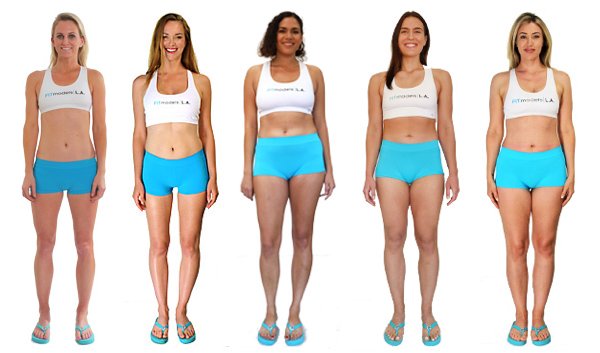Are you ever confused by the ‘size guide’ table on a brand’s website when you’re trying to figure out what to order? Your bust and waist measurement fits a 10, but your hips are a 12. Even if your measurements do line up, the fit still ends up off. What gives? In short: fit models.
Do you look like these women? (credit: Fit Models LA)
Every womenswear brand fits their samples on models that have very specific measurements, most on women they call a size 8/M. Measurements are then ‘graded’ up and down the scale from the middle respectively, ideally minimizing distortion in garment sizing (which would happen if you tried to get to a 16 based on a size 0). Specs can vary from brand to brand, but generally a ‘size 8’ about 5’7” tall, measuring 36-29-39” (bust-waist-hip), and her height is balanced between her torso and legs (inseam=height÷2). There are about two dozen other measurements considered standard for this size as well- meaning there are two dozen other ways for a garment to fit you incorrectly if your measurement is not the same as the specs.
Fit models are measured weekly to ensure consistency. No thanks.
Some brands like JCrew and Banana Republic do accommodate different heights, offering tall (over 5’7”) and petite (under 5’4”) options. Brands like Abercombie and Fitch go even further, fitting each size (0-12) uniquely and even offering a ‘curvy’ size for slightly larger hip measurements.
Brands have their reasons for designing this way. First, it saves money- each unique size requires its own set of specs, multiple factory samples, unique fit model, and scheduled fittings. Additionally, ad campaigns that feature attractive (read: proportioned) models will be the most universally appealing. Even science has shown us that we (men and women) deem symmetrical female bodies with a low waist to hip ratio optimally attractive, so this ‘ideal’ isn’t out of nowhere.
So what do the rest of us non-fit models do?
Take your measurements. This illustration will help guide you through the most important ones and how to measure them.
Know how your height is distributed. This can help you determine if you should be shopping in the petite or tall section, and for which items. You may be 5’5” but your inseam is is 34”- which means you should be looking for tall/long inseams for bottoms and petite tops.
Trial and error. As tedious as it sounds, the best way to really find the right brands and fits for your body’s proportions is to actually try them on. Order from retailers with generous return policies (Nordstrom, Bloomingdales, and Zappos, to name a few). Order multiple sizes, if possible.
Strategize your silhouettes. Even if they’re the right size, some styles just aren’t going to fit your figure. Shorter-waisted bodies with voluminous torsos are going to have a hard time fitting into anything with a waist seam. Conversely, women with more volume in their hips and rear are going to struggle with boyfriend jeans, encountering that annoying ‘waist gap’. The aforementioned trial and error can help you discover the right silhouettes for your figure.
Consider the material. Knit fabrics (e.g. jersey) tend to be more forgiving than wovens (twill). The direction of the fabric also affects the fit- garments cut on the bias (diagonal) will drape and stretch a little more than those cut on the straight (vertical) grain- think Chinese finger trap.
Take it to the tailor. Everyone says it, and for good reason. Sometimes even a tweak of 1” on a strap or hem can make all the difference. Most local dry cleaners can handle basic alterations like hems or letting out/taking in seams.
Of course, working with an expert who has experience with design, brand fits and construction (ahem) can help you build a wardrobe full of clothes that feel like they were made for you.



